Tornadoes of 2019
This page documents notable tornadoes and tornado outbreaks worldwide in 2019. Strong and destructive tornadoes form most frequently in the United States, Argentina, Brazil, Bangladesh, and Eastern India, but can occur almost anywhere under the right conditions. Tornadoes also develop occasionally in southern Canada during the Northern Hemisphere's summer and somewhat regularly at other times of the year across Europe, Asia, Argentina, and Australia. Tornadic events are often accompanied by other forms of severe weather, including strong thunderstorms, strong winds, and hail.
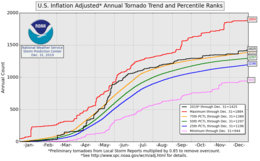 A chart of the 2019 United States tornado count estimated from the number of preliminary reports | |
| Timespan | January 4 – December 30 [1] |
|---|---|
| Maximum rated tornado | EF4 tornado
|
| Tornadoes in U.S. | 1,522 |
| Damage (U.S.) | unknown |
| Fatalities (U.S.) | 42 |
| Fatalities (worldwide) | 100 |
There were 1,676 preliminary filtered reports of tornadoes in the United States in 2019,[2] of which at least 1,522 were confirmed. This makes 2019 the fourth most active season on record, behind 2008, 2011, and 2004. Worldwide, 100 tornado-related deaths were confirmed; 42 in the United States,[3][4] 28 in Nepal, 14 in China, seven in Cuba, two each in South Africa, Turkey, and Indonesia, and one each in Chile, Italy, and Japan.
Events
United States yearly total
 Feb. 23 Mar. 3 Apr. 13 Apr. 13 Apr. 25 Apr. 30 May 22 May 22 May 25 May 27 Dec. 16 Dec. 16 Approximate touchdown location of killer tornadoes in 2019 Summary of tornadoes[5]
|
| EFU | EF0 | EF1 | EF2 | EF3 | EF4 | EF5 | Total |
|---|---|---|---|---|---|---|---|
| 179 | 653 | 534 | 120 | 33 | 3 | 0 | 1,522 |
January
There were 18 tornadoes reported in United States in January;[2] however, 22 were confirmed.
January 11 (Indonesia)
On January 11, a weak tornado formed over Bandung in the Indonesian province of West Java. No fatalities occurred, but 102 people were injured. Around 600 homes were damaged, causing $50 million in damage.[6][7]
January 19
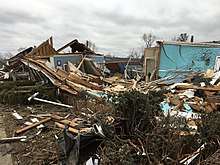
| EFU | EF0 | EF1 | EF2 | EF3 | EF4 | EF5 |
|---|---|---|---|---|---|---|
| 1 | 2 | 8 | 1 | 0 | 0 | 0 |
On January 19, the Storm Prediction Center issued a slight risk of severe weather for much of Mississippi and Alabama, along with parts of Louisiana, Georgia, and the Florida Panhandle. This included a 5% risk of tornadoes. A small tornado outbreak impacted the Deep South later that day. Five weak tornadoes struck Mississippi and Louisiana in the morning hours, including an EF1 tornado that destroyed a mobile home and a storage building and caused considerable roof damage to surrounding homes to the northeast of Franklinton, Louisiana.[8] A high-end EF2 tornado caused significant structural damage in Wetumpka, Alabama. The First Presbyterian Church was destroyed, along with the First Baptist Church, the police station, a senior center, and several homes were severely damaged or destroyed. Four people were injured.[9][10][11] An EF1 tornado near Booth, Alabama destroyed a trailer, injuring two people inside.[9] Three other EF1 tornadoes touched down in Alabama and the Florida Panhandle, including one that caused damage at Tyndall Air Force Base. Overall, this outbreak produced 10 tornadoes and resulted in six injuries.[9][12]
January 24 (Turkey)
| FU | F0 | F1 | F2 | F3 | F4 | F5 |
|---|---|---|---|---|---|---|
| 0 | 0 | 1 | 3 | 0 | 0 | 0 |
On January 24, Turkey was impacted by four tornadoes. Two people were killed and 11 injured by an F2 tornado in the Kumluca area of Antalya Province, where homes and businesses sustained major damage. Several vehicles and trailers were tossed and damaged by the tornado as well. One of the fatalities occurred when a man attempted to take shelter inside a metal cargo container at a construction site, while the other occurred as a result of a collapsed roof.[13][14] Another F2 tornado flattened a large swath of trees in a heavily forested area near Olympos, while an F1 near Kum damaged homes and greenhouses. In Sahilkent, an F2 tornado caused significant damage to vehicles as well.[15]
January 27 (Cuba)
A violent nighttime EF4 tornado struck the eastern side of Havana, Cuba's capital city, killing 7 people and injuring 193 others, some critically. The large stovepipe tornado caused extensive damage as it moved through densely populated areas of the city. Numerous well-built masonry homes and businesses were badly damaged or destroyed, including 90 homes that completely collapsed, and 30 homes that were badly damaged or partially collapsed. Many vehicles were thrown into buildings, crushed by falling debris, or were tossed and mangled beyond recognition. Numerous trees and power poles were snapped as well. This was the strongest tornado to strike Cuba in nearly 80 years, when an F4 tornado struck Bejucal on December 26, 1940.[16][17][18][19][20]
February
There were 26 tornadoes reported[2] in the United States in February; however, 27 were later confirmed.
February 23–24
| EFU | EF0 | EF1 | EF2 | EF3 | EF4 | EF5 |
|---|---|---|---|---|---|---|
| 0 | 2 | 3 | 1 | 1 | 0 | 0 |
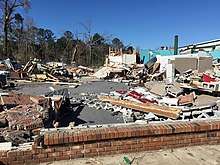
On the morning of February 23, the Storm Prediction Center issued a moderate risk of severe weather. This included a 15% hatched risk area for tornadoes. The possibility of a few strong, long-tracked tornadoes was noted. On the evening of February 23, through the early morning hours or February 24, a small tornado outbreak occurred in portions of Mississippi, Alabama and Georgia. A large, rain-wrapped EF3 tornado touched down and struck the city of Columbus, Mississippi, damaging or destroying numerous homes and businesses in town. A church was largely destroyed, and the top of a cell tower was bent over. A large brick grocery store building was almost entirely leveled, resulting in one fatality, the first of 2019. Nineteen other people were injured by the tornado.[21] An EF2 tornado also caused considerable damage to homes and trees as it clipped the west edge of Burnsville, Mississippi. In addition, an EF1 tornado near Kingville, Alabama downed hundreds of trees and destroyed a manufactured home. Overall, this outbreak produced eight tornadoes, killed one person, and resulted in 19 injuries.[22]
March
There were 145 tornadoes reported in the United States in March,[2] of which 111 were confirmed.
March 3
| EFU | EF0 | EF1 | EF2 | EF3 | EF4 | EF5 |
|---|---|---|---|---|---|---|
| 0 | 11 | 21 | 7 | 1 | 1 | 0 |
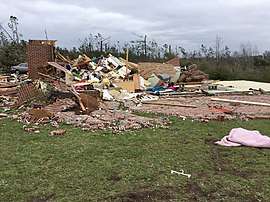
On March 1, parts of Alabama, Georgia, Florida, and South Carolina were highlighted in a slight risk for severe weather by the Storm Prediction Center. On March 2, during the evening updated outlook, the Storm Prediction Center issued an enhanced risk from eastern-most Alabama, extending through central Georgia and into western South Carolina due to the risk of a few strong tornadoes. On March 3, the Storm Prediction Center maintained the enhanced risk area, which included a 10% hatched risk area for tornadoes. Later that afternoon and evening, a tornado outbreak occurred across parts of Alabama, Georgia, Florida, and South Carolina as numerous tornadic supercell thunderstorms overspread the region. A violent, long-tracked EF4 tornado killed 23 people as it decimated the rural community of Beauregard in Lee County, Alabama. Well-built homes were leveled, trees were debarked, and vehicles were lofted and mangled beyond recognition by this violent tornado. The tornado continued through western portions of Georgia, striking Talbotton at EF3 strength and causing major damage in that town before dissipating. In addition to the 23 fatalities, 97 people were injured by the tornado.[23][24][25] The Beauregard tornado ended the record-long 673-day streak without a violent (EF4 or EF5) tornado in the United States since the last one touched down near Canton, Texas on April 29, 2017. It was also the deadliest tornado to strike the United States since the 2013 Moore tornado.[26]
Near Eufaula, a high-end EF2 tornado caused major damage to structures and aircraft at Weedon Field, and also destroyed a fire station. Another EF2 tornado caused significant damage to homes, mobile homes, and vehicles near Fort Valley, Georgia, injuring one person. The town of Cairo, Georgia was also significantly impacted by an EF2 tornado, where homes and businesses were severely damaged and two people were injured. In Florida, two people were injured when an EF3 tornado destroyed multiple homes to the east of Tallahassee. In South Carolina, an EF2 snapped large trees and power poles, damaged a gas station, and injured four people near Clarks Hill. Numerous weak tornadoes also touched down, including an EF0 that struck downtown Macon, Georgia. Overall, this outbreak produced 41 tornadoes and killed 23 people. All of the fatalities from this outbreak occurred in Lee County, Alabama as a result of the long-tracked EF4 tornado that struck Beauregard.[27]
March 12–14
| EFU | EF0 | EF1 | EF2 | EF3 | EF4 | EF5 |
|---|---|---|---|---|---|---|
| 0 | 20 | 13 | 5 | 0 | 0 | 0 |
A three-day tornado outbreak affected various regions of the United States during mid-March 2019. On March 12, an EF2 tornado impacted the city of Dexter, New Mexico. The tornado damaged or destroyed several homes and mobile homes in town, injuring 6 people. It was the earliest EF1 or stronger tornado in the state of New Mexico on record and also the first tornado in Chaves County during the month of March going back to 1959.[28] Another EF2 snapped numerous power poles near Malaga as well. Over the course of March 13, a few weak tornadoes touched down in parts of Texas, including an EF0 and an EF1 that struck the town of Junction, resulting in moderate damage. Another EF1 tornado blew off roofs in Zephyr. On March 14, the Storm Prediction Center (SPC) issued an enhanced risk of severe weather from northern Indiana and northwestern Ohio southward into northern Alabama. The most notable tornado of the day was a strong EF2 tornado that caused major structural damage to several homes and a church near Lovelaceville, Kentucky, before weakening and striking West Paducah, where a mall and several businesses sustained minor damage. The tornado narrowly missed the National Weather Service office in Paducah, and was caught on video by a meteorologist on duty.[29] Another EF2 tornado struck the small town of Vernon, Michigan, where homes had roofs and exterior walls removed and a business was destroyed. Many tornadoes touched down in Alabama on the evening of March 14, almost all of which were weak. However, an EF2 that passed near Titus severely damaged multiple homes and two convenience stores. Numerous other EF0 and EF1 tornadoes touched down in parts of Kentucky, Indiana, Michigan and Ohio as well. Overall, this outbreak produced 38 tornadoes and injured eight people.[27]
March 13 (Germany)
On March 13, a strong tornado touched down in extreme western Germany, very close to the border of Belgium. The tornado struck the town of Roetgen directly, where 40 homes were damaged, 10 of which were left uninhabitable. Two of these homes had their roofs completely destroyed, and several others sustained partial roof removal. Detached garages were destroyed, and structural debris and insulation was scattered throughout the damage path. Some debris was impaled into the exterior walls of damaged homes. Trees were snapped and uprooted, and metal street lamp poles were bent to the ground. Two warehouse buildings were also damaged, and vehicles were damaged by flying debris and falling trees as well. Five people were injured in Roetgen, four of which required hospitalization.[30][31] Based on the damage, the tornado was rated F3 in intensity.[32]
March 31 (Nepal)
On March 31, a destructive and deadly tornado tore through several villages of the Bara District and Parsa District of Nepal, killing 28 people and injuring 1,176 others. It was the country's first ever confirmed tornado.[33] Most of the dead and injured were poor and living in weakly-built houses that were destroyed. However, several well-constructed masonry structures, including a mosque, were completely leveled. A total of 1,273 homes were destroyed and a further 1,348 sustained damage. The majority of damage took place in Bara where 1,183 homes were destroyed. Vehicles were thrown, and numerous trees were snapped and denuded as well.[34][35]
April
There were 303 tornadoes reported in the United States in April,[2] of which 276 were confirmed. This made April 2019 the second most active April on record, surpassing 1974 which had 267 confirmed.
April 13–15
| EFU | EF0 | EF1 | EF2 | EF3 | EF4 | EF5 |
|---|---|---|---|---|---|---|
| 0 | 23 | 31 | 15 | 2 | 0 | 0 |
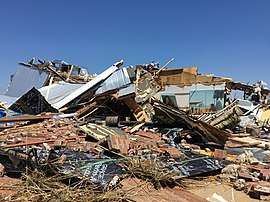
On April 13, the Storm Prediction Center issued a moderate risk of severe weather for much of Louisiana, along with portions of Texas, Arkansas, and Mississippi. This included a 15% hatched risk area for tornadoes. A highly sheared and unstable atmosphere in place over much of the Southern United States provided a favorable environment for supercells and tornadoes, including the potential for strong, long-tracked tornadoes. Throughout the afternoon and evening, a tornado outbreak unfolded as multiple significant tornadoes tracked through the outlined threat area. An EF3 tornado severely impacted the town of Franklin, Texas, destroying numerous homes and businesses, and injuring 12 people. Another long-tracked EF3 tornado struck Weeping Mary and Alto, destroying numerous homes and the Caddo Mounds State Historic Site museum, killing two people and injuring 20 more. Alto had also sustained significant damage from a separate EF2 tornado that occurred earlier in the day. Three separate EF2 tornadoes struck Vicksburg, Mississippi, damaging homes and businesses. A high-end EF2 also impacted Hamilton, destroying homes and a fire station, and killing one person there. Severe storms and tornadoes continued overnight into April 14 as the system pushed eastward, and an enhanced risk of severe weather was issued for parts of the Eastern United States, included a large 5% risk area of tornadoes extending from Georgia up to Pennsylvania. Widespread tornado touchdowns occurred in the threat area, though most were weak. However, an EF2 tornado struck Shelby, Ohio, where a Chevrolet dealership and several homes were significantly damaged, and six people were injured. A high-end EF2 tornado struck Starbrick, Pennsylvania as well, where a lumber company sustained major damage. A few additional tornadoes occurred into the early morning hours of April 15, including an EF2 that caused severe damage to homes and a warehouse near Laurel, Delaware. Overall, this outbreak produced 71 tornadoes that killed three people.[27] [36][37]
April 17–19
| EFU | EF0 | EF1 | EF2 | EF3 | EF4 | EF5 |
|---|---|---|---|---|---|---|
| 3 | 30 | 49 | 11 | 1 | 0 | 0 |
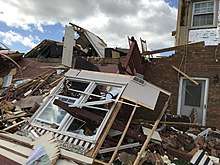
Following the previous event, another outbreak of tornadoes impacted the Deep South and Eastern United States, accompanying a strong cold front across the southern Great Plains and into the Southeast. The Texas Panhandle, Kansas, and western Oklahoma were impacted on the afternoon of April 17, with eight weak tornadoes causing little to no damage.[38][39] The next day, the Storm Prediction Center issued an enhanced risk for Mississippi and Alabama, including a 10% hatched risk area for tornadoes. A total of 40 tornadoes touched down in Mississippi that evening, a few of which were strong. One tornado that touched down in the small town of Morton severely damaged or destroyed several homes, and was rated high-end EF2. Two EF1 tornadoes downed numerous trees in Philadelphia, Mississippi as well, one of which collapsed the exterior wall of an urgent care. Two EF2 tornadoes near Learned snapped numerous large trees and power poles as well. By April 19, the severe weather threat had shifted to the Eastern United States, with a moderate risk in place for the Carolinas and Virginia. This included a 10% risk area for tornadoes, and numerous tornadoes touched down from Florida to Pennsylvania throughout the day and evening, several of which were strong. In Virginia, an EF3 passed near Rocky Mount destroying homes, tossing vehicles, and injuring two people. An EF2 tornado also ripped the roof off of a house near Mineral, while another EF2 near Charles City severely damaged a rod and gun club. A few significant tornadoes occurred across parts of the Carolinas as well, including an EF2 that significantly damaged a few homes in the southern part of Hillsborough, North Carolina. Further north, EF2 tornadoes caused considerable damage in the Pennsylvania communities of St. Thomas and Lewistown. A total of 94 tornadoes were confirmed as a result of this outbreak, none of which caused fatalities.[27]
April 24–25
| EFU | EF0 | EF1 | EF2 | EF3 | EF4 | EF5 |
|---|---|---|---|---|---|---|
| 1 | 2 | 9 | 4 | 1 | 0 | 0 |
Beginning on April 24, a small outbreak of strong tornadoes impacted Texas and Louisiana. A strong EF2 impacted the outskirts of Bryan, Texas, where a house and several warehouses sustained major structural damage, and one person was injured. Another strong tornado caused high-end EF2 damage in the town of San Augustine, Texas, where multiple homes and businesses were damaged or destroyed. During the early morning hours of April 25, a large tornado of EF3 intensity caused major damage in Ruston, Louisiana, including portions of the Louisiana Tech University campus. Numerous homes and businesses were damaged or destroyed, vehicles were lofted, and two people were killed when a large tree crushed a house. Another early-morning wedge tornado tracked from Morehouse Parish, Louisiana into Ashley County, Arkansas, mowing down hundreds of trees at EF2 intensity. Near Jena, Louisiana, an EF2 tornado ripped half of the roof off of a house and downed many trees. A few additional weak tornadoes touched down across portions of the Ohio Valley, including two EF1 tornadoes touched down near North Vernon, Indiana, causing damage to trees, vehicles, and homes. 17 tornadoes were confirmed as a result of this outbreak, which killed two people.[27]
April 30
| EFU | EF0 | EF1 | EF2 | EF3 | EF4 | EF5 |
|---|---|---|---|---|---|---|
| 1 | 17 | 26 | 3 | 1 | 0 | 0 |
During the afternoon and evening of April 30, numerous tornadoes touched down across portions of Texas, Oklahoma, Kansas, Missouri, Illinois, and Arkansas, a few of which were strong.[40] An EF3 wedge tornado killed two people, injured 9 others, and caused major damage as it passed near Blue, Oklahoma.[41][42] A high-end EF2 tornado touched down in the northern part of Ozark, Missouri before passing near Rogersville, injuring three people and destroying or heavily damaging numerous homes.[43] Significant damage to homes and businesses also occurred as a result of an EF2 tornado that struck Haileyville, Oklahoma, where one person was injured. Another EF2 caused damage to homes, barns, power lines, and outbuildings near Talala. Numerous other weak tornadoes also touched down, including an EF1 that struck Denton, Texas, downing trees at the Texas Woman's University campus and in nearby neighborhoods. Overall, this outbreak produced 48 tornadoes and killed two people.[44]
April 30 (Romania)
A F2 tornado[45] touched down near Drajna Nouă, a village in Călărași County.[46] 10 buildings sustained damage from the tornado.[47] A passenger bus was overturned by the force of the winds, injuring 12 people.[48][48]
May
There were 556 tornado reports in the United States in May,[2] of which 509 were confirmed. This made May 2019 both the most active May for tornadoes since 2004, and the single most active tornado month overall since April of 2011, where 509 and 775 confirmed tornadoes touched down respectively.
May 17–30
| EFU | EF0 | EF1 | EF2 | EF3 | EF4 | EF5 |
|---|---|---|---|---|---|---|
| 54 | 161 | 126 | 31 | 18 | 2 | 0 |
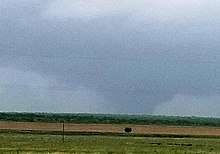
In mid- to late May, the mid-level pattern across the United States was characterized by an expansive area of high pressure across the Southeast and an abnormally strong trough across the West. With warm, moist air propagating northward from the Gulf of Mexico, and several mid-level impulses intersecting this unstable airmass, conditions became ideal for sustained and significant severe weather beginning on May 17. In the 13 following days, more than 500 reports of tornadoes were received by the Storm Prediction Center, an occurrence only seen four previous times in 2003, 2004, 2008, and 2011.[49] On May 17, multiple strong tornadoes touched down across parts of Nebraska and Kansas, though they remained in mostly rural areas. Numerous EF2 and EF3 tornadoes impacted Texas on May 18, including two EF2 tornadoes that caused significant damage in the cities of Abilene and San Angelo, and an EF3 which caused major damage in Ballinger as well. In the early morning hours of May 22, an EF2 tornado severely damaged a house near Adair, Iowa, killing one person and injuring another. Later that evening, an EF3 caused severe damage in Carl Junction, Missouri, while another EF3 destroyed homes near Golden City, killing three people and injuring one. Just before midnight, an EF3 tornado damaged or destroyed many homes and businesses in Jefferson City, killing one person and injuring 32 others. On the night of May 25, an EF3 tornado ripped through a mobile home park and a hotel in the southern part of El Reno, Oklahoma, killing two and injuring 29 others. A large outbreak of strong to violent tornadoes impacted the Ohio Valley region on the evening of May 27, including an EF3 tornado that caused severe damage in Celina, Ohio, killing one person there and injuring eight others. Dayton, Ohio and its surrounding suburbs were hit by an EF4, an EF3, and an EF2 in quick succession, resulting in widespread major damage throughout the metro area, and at least 166 injuries. On May 28, a violent, rain-wrapped EF4 wedge tornado impacted the outskirts of Lawrence and Linwood, Kansas, destroying many homes and injuring 18 people.[50] Cumulatively, a total of 392 tornadoes were confirmed through photo evidence or damage surveys. Eight tornado-related fatalities and numerous injuries occurred as a result of the outbreak sequence.[27][51]
May 30–31 (Chile)
| FU | F0 | F1 | F2 | F3 | F4 | F5 |
|---|---|---|---|---|---|---|
| 0 | 0 | 0 | 2 | 0 | 0 | 0 |
An F2 tornado hit Los Ángeles, Chile on May 30, causing damage and injuring 16 people.[52] The next day, another F2 tornado affected Talcahuano and Concepción, killing one person and injuring at least 23 people.[53]
June
There were 206 tornadoes reported in the United States in June,[2] of which 179 were confirmed.
June 6
| EFU | EF0 | EF1 | EF2 | EF3 | EF4 | EF5 |
|---|---|---|---|---|---|---|
| 0 | 4 | 13 | 1 | 0 | 0 | 0 |
A small outbreak of mostly weak tornadoes impacted Louisiana on June 6, causing minor to moderate damage. The most significant tornado was an EF2 that threw a tied-down office trailer near Sorrento, injuring five people. An EF1 also hit Baton Rouge, damaging a hospital, a warehouse, multiple vehicles, and many trees. A total of 18 tornadoes were confirmed.[50]
June 8–9
| EFU | EF0 | EF1 | EF2 | EF3 | EF4 | EF5 |
|---|---|---|---|---|---|---|
| 10 | 3 | 0 | 2 | 0 | 0 | 0 |
On June 8, an EF2 tornado touched down near Fertile, Minnesota, snapping or uprooting numerous large trees, throwing farming equipment and grain bins, and damaging or destroying barns and outbuildings. On June 9, another EF2 tornado struck the west side of Copperas Cove, Texas, downing trees and damaging 196 homes. Two of these homes sustained significant structural damage. Multiple other weak tornadoes occurred across parts of the Midwestern and Central United States. A total of 15 tornadoes were confirmed.[50]
June 15–16
| EFU | EF0 | EF1 | EF2 | EF3 | EF4 | EF5 |
|---|---|---|---|---|---|---|
| 3 | 17 | 16 | 6 | 0 | 0 | 0 |
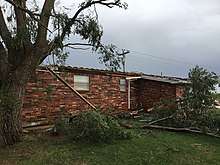
On June 15, a moderate tornado outbreak impacted parts of the Great Plains and Midwest. An EF2 caused major tree and outbuilding damage near Elletsville, Indiana, while another EF2 caused significant tree and structural damage near Koleen. Another EF2 near Rushville destroyed a garage, heavily damaged a house, and destroyed silos and outbuildings. An EF1 also moved through Beech Grove, causing roof damage to multiple structures, and another EF1 tornado caused damage in Freedom. Two EF2 tornadoes caused severe damage to homes, snapped trees and power poles, destroyed outbuildings, and tossed vehicles and farming equipment near Oakville, Iowa. In Oklahoma, an EF2 tornado ripped the roof off a house and snapped multiple power poles near Custer City. Multiple other weak tornadoes occurred across the Great Plains the following day, including an EF1 that damaged homes and trees in Arlington, Texas. An EF1 tornado also struck the town of Parker, Pennsylvania, causing moderate damage to structures and trees. Overall, this outbreak produced a total of 42 tornadoes.[50]
June 29
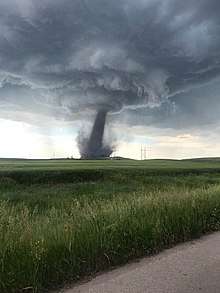
An isolated low-precipitation supercell formed near Allen, South Dakota, producing a long-lived, nearly stationary tornado in some open fields. Due to the visibility and relatively flat region the tornado formed in, it could reportedly be seen dozens of miles away. There was some damage to farms, trees, and crops and several deer were killed. The tornado was rated EF1.[54] This unusual tornado has been described as a "hybrid" between a landspout and a typical supercell-spawned tornado.[55]
July
There were 103 tornadoes reported in the United States in July,[2] of which 100 were confirmed.
July 3 (China)
A violent stovepipe tornado moved through the city of Kaiyuan in Liaoning Province, Northeastern China, killing six people and injuring 190. Numerous homes sustained major structural damage, with roofs removed and exterior walls collapsed, while several multi-story apartment buildings were significantly damaged. Multiple industrial buildings and factories were also significantly damaged or completely destroyed, with metal support beams severely mangled. The most intense damage was noted at a large reinforced concrete cafeteria building which was almost entirely leveled. Trees were snapped, twisted, and debarked and power poles were snapped as well. Vehicles were also thrown and destroyed, and farm fields in rural areas outside of the city were heavily scoured. The tornado was rated EF4 in intensity.[56][57]
July 23
| EFU | EF0 | EF1 | EF2 | EF3 | EF4 | EF5 |
|---|---|---|---|---|---|---|
| 0 | 1 | 4 | 0 | 0 | 0 | 0 |
Between late July 22 and early July 23, several rounds of powerful thunderstorms moved through Rhode Island and southeastern Massachusetts, prompting rare tornado warnings for the region. Around mid-day of July 23, two EF1 tornadoes struck two different towns on Cape Cod. One tornado touched down in West Yarmouth, ripping off the roof of the Cape Sands Inn, uprooting dozens of trees, and sending one tree into a residence. This tornado lifted ten minutes later in South Yarmouth. The second EF1 struck Harwich, snapping trees and ripping shingles off of roofs before lifting five minutes later. A survey by NWS meteorologists discovered a third EF1 struck Harwich, remaining on the ground for only one minute. No casualties were reported. Just three other confirmed tornadoes have occurred on Cape Cod since 1950, one of which occurred just nine months prior in October 2018. Two other weak tornadoes touched down in North Carolina, and a total of five tornadoes were confirmed as a result of this event.[58]
July 28 (Europe)
| FU | F0 | F1 | F2 | F3 | F4 | F5 |
|---|---|---|---|---|---|---|
| 5 | 5 | 0 | 1 | 0 | 0 | 0 |
At around 2:00 a.m. on July 28, an F2 tornado hit Fiumicino in Central Italy, passing near the Leonardo da Vinci–Fiumicino Airport. The tornado tossed and flipped multiple cars, killing a woman inside one of them. The tornado also damaged several homes and a gas station, bent signs to the ground, and downed trees and brick fences as well. The tornado was a part of a small outbreak of 11 otherwise weak tornadoes and tornadic waterspouts that impacted several countries in Europe that day. An F0 tornado caused roof and chimney damage in the Klagstorp, Sweden area, while another weak tornado caused damage to trees and vehicles in Jönköping County Sweden.[59][60]
August
There were 75 tornadoes reported in the United States in August;[2] however, 78 were confirmed.
August 9 (Europe)
| FU | F0 | F1 | F2 | F3 | F4 | F5 |
|---|---|---|---|---|---|---|
| 4 | 0 | 2 | 1 | 0 | 0 | 0 |
A small outbreak of seven tornadoes impacted Europe on August 9, including an F1 rope tornado that touched town in downtown Amsterdam, Netherlands. This tornado was caught on video by many tourists and locals as it caused roof damage to structures and damaged trees. A tourist boat was also struck and damaged by the tornado as well. Another F1 tornado near Hem, Netherlands snapped trees, overturned two trailers, and damaged greenhouses. The most significant event of the outbreak was a strong tornado that touched down in northeastern France, causing damage to roofs and vehicles in the Longwy and Herserange areas. The tornado crossed into Luxembourg and grew into a multiple-vortex, high-end F2 tornado that tore directly through Rodange, Lamadelaine, and Pétange, injuring 19 people, two critically. Numerous homes, apartment buildings, and multi-story brick buildings had their roofs torn off, and a few sustained some failure their upper floor exterior walls. Streets were littered with debris, and numerous vehicles were crushed and damaged by falling bricks and flying debris. Many trees were snapped or uprooted, and large metal truss transmission towers were toppled to the ground. Billboards and signs were blown over as well. In western Russia, a tornado of unknown intensity caused considerable damage to homes in the small village of Malyy Karamas, while another tornado caused minor tree and roof damage in the village of Kurgem. Two other weak tornadoes were confirmed near Kuressaare, Estonia and Beausite, France, causing little to no damage.[60]
August 11–12 (New Zealand)
Severe thunderstorms hit New Zealand's North Island with hail and tornadoes over two consecutive days. On August 11, severe thunderstorms hit Auckland, with a tornado hitting the suburb of Saint Heliers and lifting roofs.[61] More severe thunderstorms developed on the following day. Two tornadoes were reported from the Taranaki region, causing damage to houses and injuring one person. A tornadic waterspout touched down at the Auckland waterfront, damaging boats and businesses, and causing a container to fall on a car, injuring a person inside.[62][63] Large hail, lightning and torrential rain accompanied the tornadoes.[64]
August 20
| EFU | EF0 | EF1 | EF2 | EF3 | EF4 | EF5 |
|---|---|---|---|---|---|---|
| 0 | 0 | 2 | 0 | 1 | 0 | 0 |
Three tornadoes embedded in a line of severe thunderstorms caused damage in Iowa on August 20. Near Van Meter, Iowa, a brief EF1 tornado caused damage to trees and a residence. Another EF1 tornado near Harvey, Iowa caused minor damage to crops, trees, and buildings. The most significant tornado of the event was a strong EF3 near Lacona, Iowa that tore through the Iowa Operator Engineers Training Facility, where multiple large metal warehouse buildings were completely destroyed, with debris scattered throughout the area. Metal footings were ripped out of concrete at a few of these structures. Elsewhere along the path, trees, grain bins, and a few farmsteads sustained less severe damage[65][66]
August 29 (China)
On the night of August 29, a strong EF2 tornado struck Nada, Hainan in South China, causing eight fatalities and leaving two people injured. Multiple factories and industrial buildings were severely damaged or destroyed, and homes sustained significant damage as well. The fatalities occurred when temporary housing for workers at a construction site was obliterated. Many trees and power poles were downed, some of which landed on structures and vehicles.[67]
September
There were 87 tornadoes reported in the United States in September,[2] of which 83 were confirmed.
September 5 (Hurricane Dorian)
| EFU | EF0 | EF1 | EF2 | EF3 | EF4 | EF5 |
|---|---|---|---|---|---|---|
| 0 | 18 | 5 | 2 | 0 | 0 | 0 |
On September 5, approach and landfall of Hurricane Dorian produced a small tornado outbreak across the Carolinas, as embedded supercells within the outer bands of the hurricane came ashore. An EF1 tornado struck Little River, South Carolina, damaging docks, trees, and homes. In North Myrtle Beach, an EF0 tornado damaged mobile homes and condominiums. A majority of the tornadoes occurred in North Carolina, including a damaging EF2 that destroyed numerous RVs and mobile homes in Emerald Isle, as well as causing severe roof damage to some frame homes. Another EF2 tornado struck Carolina Shores, tearing large sections of roof off multiple homes, snapping many trees, and injuring one person. Two separate EF0 tornadoes struck Wilmington, resulting in minor damage to trees and homes in the city. Another EF0 moved through downtown New Bern, causing minor tree and awning damage. A total of 25 tornadoes were confirmed as a result of this outbreak.[68][50]
September 10–11
| EFU | EF0 | EF1 | EF2 | EF3 | EF4 | EF5 |
|---|---|---|---|---|---|---|
| 2 | 3 | 1 | 6 | 0 | 0 | 0 |
On September 10, multiple tornadoes occurred across parts of the Northern Great Plains, several of which were strong. A multiple-vortex, EF2 wedge tornado passed through rural areas near Laramie, Wyoming, causing significant damage to homes and other structures.[69] Just before midnight, three separate brief, but strong EF2 tornadoes impacted the city of Sioux Falls, South Dakota, causing severe damage. The first tornado struck residential areas in the south side of town, where several homes had roofs and exterior walls ripped off. The second tornado struck the Avera Behavioral Health Center and Avera Heart Hospital in southeastern Sioux Falls, where numerous windows were blown out, and eight people were injured by flying glass. The hospital also sustained considerable roof and facade damage, and cars were tossed in the parking lot. The third tornado touched down closer to the downtown area of the city, flipping cars, severely damaging businesses, and tearing the roof off a multi-story apartment building. Numerous trees were snapped or uprooted by the three tornadoes as well. Several other weak tornadoes also touched down across the region that day as well.[70] On September 11, two EF2 tornadoes occurred near Fleming, Colorado, with one snapping power poles and the other destroying a pole barn. A brief EF0 tornado also touched down in Grand Rapids, Michigan, blowing the roof off an apartment building. A total of 12 tornadoes were confirmed.[50]
September 24
| EFU | EF0 | EF1 | EF2 | EF3 | EF4 | EF5 |
|---|---|---|---|---|---|---|
| 4 | 2 | 1 | 0 | 1 | 0 | 0 |
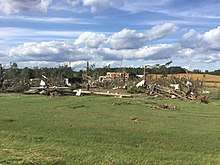
On the night of September 24, a large tornado touched down in the village of Elk Mound, Wisconsin, where trees were downed and a few homes sustained moderate damage. The tornado continued to the northeast and intensified as it passed through rural areas outside of town, reaching EF3 intensity and destroying several homes and mobile homes in the area. Vehicles were tossed and damaged, while barns, outbuildings, and self-storage units were destroyed, and numerous trees were snapped, denuded, and partially debarked as well. Three people were injured by the tornado. An EF1 tornado passed near Greenwood, Wisconsin, damaging trees, silos, and barns, and killing three cows. Further east, an EF0 tornado caused minor damage in Lake City, Minnesota. A few other weak tornadoes touched down in Kansas, Texas, and Iowa as well. A total of eight tornadoes were confirmed.[71][50]
October
There were 66 tornadoes reported in the United States in October,[2] of which 62 were confirmed.
October 12 (Japan)
On October 12, Typhoon Hagibis produced a strong F2 wedge tornado that ripped through Chiba Prefecture, causing severe damage in Ichihara, south-east of Tokyo. Several homes sustained major structural damage, some of which sustained roof loss and exterior wall damage. Multiple cars were thrown and damaged, and one man was killed when his vehicle was flipped by the tornado. Debris was strewn across roads and wrapped around power lines, and trees and power poles were snapped. At least five other people were injured.[72][73]
October 20–22
| EFU | EF0 | EF1 | EF2 | EF3 | EF4 | EF5 |
|---|---|---|---|---|---|---|
| 0 | 13 | 20 | 2 | 1 | 0 | 0 |
On the night October 20, an intense, destructive EF3 tornado moved through densely populated areas of Dallas and Richardson, Texas. Numerous homes, businesses, schools, churches, and other buildings were severely damaged or destroyed by the tornado. Numerous trees and power lines were downed throughout the path as well.[74] A high-end EF2 tornado also struck the suburb of Garland, Texas and heavily damaged multiple warehouse buildings and homes. Several other tornadoes impacted areas in and around the Dallas–Fort Worth metroplex that night, including a high-end EF1 that moved through residential areas in Rowlett and Wylie, causing considerable roof damage to numerous homes.[75] The next day, a very large 1.5-mile (2.4 km)-wide EF2 tornado hit Siloam Springs, Arkansas, damaging many homes and businesses. The tornado continued to the northeast and caused additional damage in Rogers, Arkansas. An EF1 tornado also struck Memphis, Tennessee, damaging an apartment complex, businesses, and trees.[76] Two weak EF0 tornadoes touched down on October 22, causing minor damage before the outbreak came to an end. A total of 36 tornadoes were confirmed as a result of this outbreak.[50]
October 20 (Indonesia and Malaysia)
On October 20, a tornado swept through three different villages in Batu, East Java in Indonesia, causing one fatality and destroying about 20 houses. The tornado also snapped several trees and damaged parts of the electricity network within the affected villages.[77] Another tornado was reported near Kedah in Malaysia, destroying two dozen homes.[78][79]
October 31–November 1
| EFU | EF0 | EF1 | EF2 | EF3 | EF4 | EF5 |
|---|---|---|---|---|---|---|
| 0 | 4 | 5 | 1 | 0 | 0 | 0 |
On the evening of October 31, a fast-moving and powerful cold front swept through the Eastern United States. Several tornadoes touched down, the most significant of which was an EF2 that stuck the Philadelphia suburb of Glen Mills, Pennsylvania. The tornado heavily damaged three homes in town, and caused lesser damage to several others. Numerous trees were snapped or uprooted by the tornado, and two people were injured. Several other EF0 and EF1 tornadoes occurred in Tennessee, Virginia, and South Carolina that evening as well. The storm system produced a few additional tornadoes across the region on November 1 as well, including an EF1 that moved through Madison, New Jersey, downing numerous trees. Some of the trees landed on homes, vehicles, and power lines. Another EF1 tornado impacted the south edge of Chesapeake, Virginia as well, destroying an RV camper and inflicting roof, shingle, and gutter damage to several homes. A total of 10 tornadoes were confirmed.[80][81]
November
There were 19 tornadoes reported in the United States in November,[2] all of which were confirmed.
November 4 (Greece)
On November 4, right after 1 PM, a large F1 tornado touched down in the Greek city of Kalamata and swept through an olive oil factory, causing considerable damage. Fortunately, no casualties were reported.[82]
November 12 (South Africa)
The South African Weather Service confirmed a tornado of unclassified strength tornado near New Hanover, KwaZulu-Natal.[83] The strong tornado snapped and uprooted numerous trees, and damaged or destroyed multiple homes. Two people were killed and several more were injured.[84][85]
November 18 (New Zealand)
A tornado tore through the city of Christchurch on November 18, tearing off roofs, shattering windows, and injuring two people. Fortunately, no deaths were reported. The tornado was accompanied by a severe thunderstorm which brought hail, lightning and thunder as well as a waterspout that was spotted out at sea at New Brighton.[86][87][88][89]
November 26–27
| EFU | EF0 | EF1 | EF2 | EF3 | EF4 | EF5 |
|---|---|---|---|---|---|---|
| 1 | 3 | 2 | 2 | 0 | 0 | 0 |
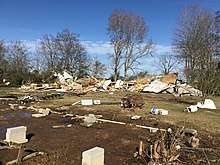
A cold front brought rain showers, gusty winds, and severe weather to the Southern United States on the night of November 26. A few tornadoes, two of them strong, touched down in Louisiana and Mississippi. An EF2 tornado near Baskin, Louisiana destroyed two mobile homes, downed trees and power poles, and slid a church partway off its foundation. Two people, one of whom later died, were injured in one of the mobile homes.[4] Another EF2 tornado damaged homes and destroyed outbuildings in Star, Mississippi. Two EF1 tornadoes in Louisiana and Mississippi also caused damage that was mostly limited to trees. On the morning of November 27, a low-topped supercell spawned three brief EF0 tornadoes in Pike and Barbour Counties, Alabama and caused minor damage. An EF1 tornado downed large trees and tree limbs near Puckett, Mississippi as well. A total of eight tornadoes were confirmed.[90][91][92][93][94]
November 29
On November 29, an unusual nighttime tornado event occurred in Arizona, as four weak touched down at night in the suburbs of Phoenix. The strongest tornado of the event was an EF1 that moved through Glendale and Scottsdale, blowing off roofs and downing large trees, some of which landed on vehicles. A separate EF0 tornado also moved through Glendale and Scottsdale, downing additional trees and tearing off carports. An EF0 tornado also caused minor tree damage in Higley, while another EF0 struck Queen Creek, damaging roofs and downing trees and power poles.[95]
December
There were 72 tornadoes reported in the United States in December, of which 56 were confirmed.
December 5 (Indonesia)
On December 5, thunderstorms were reported over Indonesia. One storm over Rote Island produced a waterspout which moved onshore, becoming a landspout and causing significant damage.[96]
December 10 (Indonesia)
A waterspout moved onshore and struck Bangkalan, causing significant damage but no fatalities. Another rain-wrapped tornado touched down nearby and killed one person.[97][98]
December 16–17
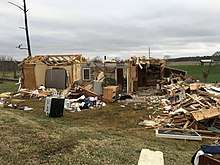
| EFU | EF0 | EF1 | EF2 | EF3 | EF4 | EF5 |
|---|---|---|---|---|---|---|
| 0 | 13 | 13 | 9 | 5 | 0 | 0 |
A significant tornado outbreak unfolded across the Southern United States, particularly in Louisiana, Mississippi, and Alabama during the afternoon and evening of December 16. The Storm Prediction Center had issued a moderate risk with a 15% chance of significant tornadoes for the region after an upgrade from enhanced risk. The event was well forecasted, with outlooks being issued as far out as day 5. Many PDS tornado warnings and a rare tornado emergency in Alexandria, Louisiana were issued. An EF3 tornado struck Alexandria and areas outside of town, causing major damage and one fatality. Two more fatalities occurred in Lawrence County, Alabama as a result of an EF2 tornado that struck near Town Creek. EF3 tornadoes also caused severe damage in and around the towns of Sumrall and Laurel, Mississippi. Significant damage from EF2 tornadoes also occurred in Guntown and Columbia, Mississippi as well. Numerous other tornadoes, several of which were strong, impacted rural areas as well. On December 17, a few additional tornadoes touched down in Georgia, including a high-end EF2 that caused major damage to structures in the small community of Mystic. Overall, this outbreak resulted in three fatalities and produced a total of 40 tornadoes.[99][100][101][102][103]
December 28–29
| EFU | EF0 | EF1 | EF2 | EF3 | EF4 | EF5 |
|---|---|---|---|---|---|---|
| 0 | 5 | 5 | 0 | 0 | 0 | 0 |
A shortwave trough moved across New Mexico and Texas on December 28 and developed into a low that moved across the southeastern United States on December 29, bringing severe thunderstorms to the Midwest and Deep South.[104][105][106][107] On December 28, two EF0 tornadoes damaged mobile homes and farm buildings in Oklahoma and Missouri.[108][109] Activity was more intense on the afternoon and evening of December 29 when a series of eight EF0 and EF1 tornadoes touched down in Mississippi, damaging homes and outbuildings and causing extensive tree damage. A total of 10 tornadoes were confirmed.[110][111]
See also
- Tornado
- Tornadoes by year
- Tornado records
- Tornado climatology
- Tornado myths
- List of tornado outbreaks
- List of F5 and EF5 tornadoes
- List of North American tornadoes and tornado outbreaks
- List of 21st-century Canadian tornadoes and tornado outbreaks
- List of European tornadoes and tornado outbreaks
- List of tornadoes and tornado outbreaks in Asia
- List of Southern Hemisphere tornadoes and tornado outbreaks
- List of tornadoes striking downtown areas
- Tornado intensity
References
- "Antalya'da hortum, tırı kaldırdı". Ensonhaber.
- "Annual Severe Weather Report Summary 2019". Storm Prediction Center. Retrieved February 14, 2019.
- "Annual U.S. Killer Tornado Statistics". Storm Prediction Center. Retrieved March 12, 2019.
- Louisiana Event Report: EF2 Tornado (Report). National Centers for Environmental Information. National Weather Service Weather Forecast Office in Jackson, Mississippi. 2020. Retrieved February 20, 2020.
- "Annual U.S. Killer Tornado Statistics". Storm Prediction Center. National Oceanic and Atmospheric Administration. Retrieved March 16, 2019.
- Afifa, Laila (2019-01-12). "Hundreds of Houses Damaged by Tornado in Bandung". Tempo. Retrieved 2019-10-25.
- Post, The Jakarta. "Tornado hits Bandung, damaging houses". The Jakarta Post. Retrieved 2019-10-25.
- NWS Damage Survey For January 19th Tornado Event (Report). Iowa Environmental Mesonet. National Weather Service Weather Forecast Office in New Orleans, Louisiana. January 20, 2019. Retrieved January 20, 2019.
- NWS Damage Survey For January 19th Tornado Event (Report). Iowa Environmental Mesonet. National Weather Service Weather Forecast Office in Birmingham, Alabama. January 21, 2019. Retrieved January 20, 2019.
- "Tornado damages 2 churches, police station and 25+ homes in Alabama town". Associate Press. Retrieved 21 January 2019.
- "Damage from EF2 tornado reported in Wetumpka, Alabama". AccuWeather. Retrieved 20 January 2019.
- "NWS Damage Survey for 1/19/2019 Tornado Event". Iowa Environmental Mesonet. National Weather Service Office in Tallahassee, Florida. Retrieved 21 January 2019.
- "Turkey Slammed by Storms, Tornadoes That Kill 2, Injure Dozens". Retrieved January 28, 2019.
- "Tornado in Turkish Mediterranean kills 2, injures 11". Retrieved January 28, 2019.
- "European Severe Weather Database". www.eswd.eu. Retrieved 4 March 2019.
- "Havana tornado: Cuba's capital hit by rare twister". BBC News. Retrieved 28 January 2019.
- "The Latest: Havana hit by Category F3 tornado". StarTribune. Retrieved 24 February 2019.
- "Huge tornado in Cuba kills 4 and injures 195". CNN News. Retrieved 24 February 2019.
- Cappucci, Matthew (28 January 2019). "A deadly tornado plowed through Havana on Sunday night. Here's how it happened". The Washington Post. Retrieved 29 January 2019.
- "Death Toll Rises to Six From Rare Havana Tornado". Weather Underground. 4 February 2019. Retrieved 5 February 2019.
- "Tornado hits Columbus Mississippi: One death confirmed, others injured". Clarion Ledger. Retrieved 24 February 2019.
- "Tornado touches down in north Mississippi, damages reported". FOX 13 Memphis. Retrieved 24 February 2019.
- "Tornadoes kill at least 23, injure dozens more in Alabama". NBC News. March 3, 2019. Retrieved 3 March 2019.
- Miles, Frank (2019-03-03). "At least 23 dead, many injured, in apparent large tornado in Alabama, officials say; fatalities could rise". Fox News. Retrieved 2019-03-04.
- "NWS says Lee County tornado 'at least' an EF3 in preliminary assessment; more details Monday". AL.com. March 3, 2019. Retrieved 4 March 2019.
- Frazier, Stephanie (August 12, 2017). "NWS: Weekend tornado strongest to hit Van Zandt County in nearly a century". KLTV News. Retrieved 2019-03-04.
- "NWS Damage Assessment Toolkit". apps.dat.noaa.gov.
- NWS Damage Survey For 03/12/2019 Tornado Event (Report). Iowa Environmental Mesonet. National Weather Service Weather Forecast Office in Albuquerque, New Mexico. March 13, 2019. Retrieved March 13, 2019.
- NWS Damage Survey for 03/14/19 Cunningham KY Tornado Event (Report). Iowa Environmental Mesonet. National Weather Service Weather Forecast Office in Paducah, Kentucky. March 14, 2019. Retrieved March 14, 2019.
- "Tief "Franz": Unwetter und ein Tornado über Roetgen". www1.wdr.de. 14 March 2019.
- Aachener Zeitung (2019-03-14). "Tornado zerstört Dutzende Häuser in Roetgen". Aachener-zeitung.de. Retrieved 2019-05-01.
- Dalkowski, Sebastian. "Meteorologin zu Sturm in Roetgen: "Es gibt in Deutschland keine Tornado-Region"". RP ONLINE.
- Mallapaty, Smriti (April 12, 2019). "Nepali scientists record country's first tornado". Nature. doi:10.1038/d41586-019-01159-w – via www.nature.com.
- "Most Bara 'tornado' victims were poor, with weaker homes". My Republica. Retrieved 11 April 2019 – via MSN.com.
- "Tornado confirmed in Bara and Parsa, Southern Nepal - Integration Through Media !". Nepal24hours.com. Retrieved 2019-05-01.
- "Annual Severe Weather Report Summary". Storm Prediction Center. Retrieved March 5, 2019.
- "Deadly tornado strikes Mississippi, bringing weekend death toll to 3 - AccuWeather.com". m.accuweather.com. Retrieved 2019-04-14.
- NWS Damage Survey for 04/17/19 Tornado Event in Texas (Report). Iowa Environmental Mesonet. National Weather Service Weather Forecast Office in Amarillo, Texas. April 18, 2019. Retrieved April 18, 2019.
- NWS Damage Survey for 04/17/19 Tornado Event near Shattuck, OK (Report). Iowa Environmental Mesonet. National Weather Service Weather Forecast Office in Norman, Oklahoma. April 18, 2019. Retrieved April 18, 2019.
- "Tornadoes, hail and flash flooding spread damage across central US - AccuWeather.com". m.accuweather.com. Retrieved 2019-05-01.
- Scavelli, Melissa (2019-05-02). "Oklahoma sees first EF3 tornado of the season". OKCFOX. Retrieved 2 May 2019.
- "Second death in wake of Bryan County tornado". KTEN.com. Retrieved May 3, 2019.
- "NWS Damage Survey for 04/30/2019 Tornado Event #4". Iowa Environmental Mesonet. National Weather Service Office in Springfield, Missouri. Retrieved 1 May 2019.
- "NWS Damage Assessment Toolkit".
- "Selected data from the database". European Severe Weather Database. Retrieved 11 May 2019.
- Manuel Crespo Feliciano (1 May 2019). "Onlookers capture breathtaking photos and video of monstrous tornado roaring through field in Romania". AccuWeather.
- "Watch: Powerful tornado touches down in Romanian countryside leaving wreckage behind". Euronews. 2 May 2019.
- "Romania tornado overturns bus and leaves 12 hurt". BBC News. 1 May 2019.
- Brian Sullivan (May 29, 2019). "The U.S. Has Had 500 Tornadoes in 30 Days". Bloomberg L.P. Retrieved May 29, 2019.
- "NWS Damage Assessment Toolkit". apps.dat.noaa.gov.
- Schmidt, Amanda. "May 2019 could be historic month for tornadoes after unprecedented twister streak finally ends at 13 days". AccuWeather. Retrieved June 2, 2019.
- BNO News, Chile (May 30, 2019). "Rare tornado hits central Chile, causing injuries". Retrieved 31 May 2019.
- infobae News, Chile (May 31, 2019). "Un muerto, 24 heridos y 546 viviendas afectadas dejó el paso de un tornado por el sur de Chile". Retrieved June 1, 2019.
- South Dakota Event Report: EF1 Tornado (Report). National Centers for Environmental Information. National Weather Service Weather Forecast Office in Rapid City, South Dakota. 2019. Retrieved January 26, 2019.
- Davies, Jon (1 July 2019). "A surprise photogenic tornado in southwest South Dakota on June 29, 2019". Jon Davies Severe Weather Notes. Retrieved 26 January 2020.
- Humayun, Hira. "Tornado tears through Chinese city of Kaiyuan killing 6 and affecting 9,000". CNN International Edition. Retrieved July 6, 2019.
- https://www.washingtonpost.com/weather/2019/07/05/tornadoes-are-rare-china-this-one-stayed-ground-minutes-ravaging-buildings-killing-six/
- "Third tornado struck Cape Cod in last week's outbreak, meteorologists say". WCVB. July 25, 2019.
- "Storms claim three lives in Italy". The Straits Times. Retrieved August 23, 2019.
- "European Severe Weather Database". eswd.eu.
- "Wild weather aftermath: 'The place looks like a war zone' - Auckland resident". The New Zealand Herald. August 12, 2019. Retrieved September 14, 2019.
- "More wild weather: Tornado strikes New Plymouth". The New Zealand Herald. August 12, 2019. Retrieved September 14, 2019.
- McRae, Tom (August 19, 2019). "Pictures of devastating tornado tearing through Auckland's Viaduct Harbour". Newshub. Retrieved September 14, 2019.
- Ensor, Jamie (August 13, 2019). "Auckland, Taranaki battered by large, spiky hail in 'epic' storm". Newshub. Retrieved September 14, 2019.
- "Lacona tornado in central Iowa now rated EF-3, strongest since October 2013". KCRG.com. Retrieved August 24, 2019.
- US Department of Commerce, NOAA. "August 20, 2019 Central Iowa Tornadoes". www.weather.gov.
- Zhiping, Ma. "Tornado kills 8 in western Hainan". China Daily. Retrieved September 17, 2019.
- "Tornado leaves destruction in North Carolina". CBS News. Retrieved September 7, 2019.
- Ernest, Dennis. "NWS confirms EF2 tornado hit north of Ft. Laramie". KTIC Radio. Retrieved September 17, 2019.
- Golembo, Max; Katz, Rachel; Peck, Dan; Shapiro, Emily. "First tornadoes in 18 years hit Sioux Falls, leaving destruction in their wake". ABC News. Retrieved September 17, 2019.
- Lauritsen, John. "EF3 Tornado Leaves Extensive Damage In Western Wisconsin". CBS Minnesota. Retrieved September 29, 2019.
- "Tornado hits in Japan as country braces itself for typhoon". euronews. Retrieved October 12, 2019.
- "Tornado hits in Japan as country braces itself for typhoon". euronews. October 12, 2019.
- Allen, Silas (2019-10-22). "After Tornado, Some Dallas Students Move to New Schools". Dallas Observer. Retrieved 2019-10-30.
- akrherz@iastate.edu, daryl herzmann. "IEM :: PNS from NWS FWD". mesonet.agron.iastate.edu.
- akrherz@iastate.edu, daryl herzmann. "IEM :: PNS from NWS TSA". mesonet.agron.iastate.edu.
- Post, The Jakarta. "One dead, thousands displaced by East Java tornado". The Jakarta Post. Retrieved 2019-10-23.
- "Trees uprooted, houses damaged after landspout strikes village in Kubang Pasu". The Star Online. 2019-10-20. Retrieved October 22, 2019.
- "Watch: Mini-tornado strikes Kedah villages; 20 houses damaged". www.nst.com.my. Retrieved October 22, 2019.
- Cherry, Amy. "VIDEO | Tornado confirmed in Glen Mills, PA". WDEL 101.7FM.
- gyee@postandcourier.com, Gregory Yee. "Halloween brings strong thunderstorms to Charleston, possible tornado to Columbia". Post and Courier.
- Fedschun, Travis (November 7, 2019). "Tornado rips through olive oil factory in Greece, sending debris in the air". Fox News.
- http://www.weathersa.co.za/Documents/Corporate/Media%20Release%2013%20November.pdf
- "WATCH | 'I heard loud screaming' - mourning mom relives moment tornado took her daughter's life". News24. November 14, 2019.
- "Another tornado strikes KwaZulu-Natal: 'Calm black clouds transformed into a funnel'". News24. 2019-11-14. Retrieved 2019-11-14.
- "Destructive Christchurch tornado very weak, could have been worse". Stuff.
- "Christchurch tornado throws van 15 metres". Stuff.
- "Tornado injures two in Christchurch". Otago Daily Times Online News. November 18, 2019.
- "Watch: Large waterspout spotted off Canterbury coast". 1 NEWS.
- NWS Damage Survey For 11/26-27/19 Tornado Event (Report). Iowa Environmental Mesonet. National Weather Service Weather Forecast Office in Jackson, Mississippi. November 27, 2019. Retrieved November 28, 2019.
- "EF-1, EF-2 tornadoes confirmed in Mississippi Tuesday night". NewsCenter11. 27 November 2019. Retrieved 28 November 2019.
- Storm survey plan for Wednesday, November 27th (Report). Iowa Environmental Mesonet. National Weather Service Weather Forecast Office in Birmingham, Alabama. November 27, 2019. Retrieved November 28, 2019.
- NWS Damage Survey For 11/27/19 Brief and Weak tornadoes in Pike and Barbour Counties (Report). Iowa Environmental Mesonet. National Weather Service Weather Forecast Office in Birmingham, Alabama. November 30, 2019. Retrieved November 30, 2019.
- NWS Damage Survey For November 26, 2019 Tornado Event (Report). Iowa Environmental Mesonet. National Weather Service Weather Forecast Office in Shreveport, Louisiana. November 27, 2019. Retrieved November 28, 2019.
- US Department of Commerce, NOAA. "Thanksgiving Holiday Phoenix Tornado and Severe Wind Event". www.weather.gov.
- "Angin Puting Beliung Terjang Pulau Rote". Mina News (in Indonesian). 2019-12-04. Retrieved 2019-12-08.
- Okezone (2019-12-10). "Viral Angin Puting Beliung Porak Porandakan Bangkalan Madura : Okezone News". https://news.okezone.com/ (in Indonesian). Retrieved 2019-12-11. External link in
|website=(help) - "Hujan & Angin Kencang di Bangkalan dan Kediri, Satu Orang Tewas Tertimpa Pohon". KOMPAS.tv (in Indonesian). Retrieved 2019-12-11.
- "SPCStorm reports for 12/16/19". Storm Predicting Center. Retrieved 16 December 2019.
- Tornado Emergency for Alexandria (Report). Iowa Environmental Mesonet. National Weather Service Weather Forecast Office in Lake Charles, Louisiana. December 16, 2019. Retrieved December 16, 2019.
- Tornado Warning (Report). Iowa Environmental Mesonet. National Weather Service Weather Forecast Office in Lake Charles, Louisiana. December 16, 2019. Retrieved December 16, 2019.
- Tornado Warning (Report). Iowa Environmental Mesonet. National Weather Service Weather Forecast Office in Jackson, Mississippi. December 16, 2019. Retrieved December 16, 2019.
- Birmingham, N. W. S. (December 17, 2019). "Preliminary damage info from the Salt Well Community on US 80 just west of Demopolis (Marengo County): EF-2 damage was found, with winds estimated of 120mph. Two mobile homes were also destroyed at this location and 3 injuries were reported. Survey is still ongoing. #alwxpic.twitter.com/YOFCILeznN".
- "Dec 28, 2019 2000 UTC Day 1 Convective Outlook". Storm Prediction Center. Retrieved 31 December 2019.
- "Dec 29, 2019 2000 UTC Day 1 Convective Outlook". Storm Prediction Center. Retrieved 31 December 2019.
- "SPC Storm Reports for 12/28/19". Storm Prediction Center. Retrieved 31 December 2019.
- "SPC Storm Reports for 12/29/19". Storm Prediction Center. Retrieved 31 December 2019.
- NWS Damage Survey for 12/28/19 Tornado Event (Report). Iowa Environmental Mesonet. National Weather Service Weather Forecast Office in Tulsa, Oklahoma. December 29, 2019. Retrieved December 30, 2019.
- NWS Damage Survey for 12/28/19 Tornado Event (Report). Iowa Environmental Mesonet. National Weather Service Weather Forecast Office in Springfield, Missouri. December 29, 2019. Retrieved December 29, 2019.
- NWS Damage Survey Teams Found 7 Tornadoes from the 12/29/19 Tornado Event (Report). Iowa Environmental Mesonet. National Weather Service Weather Forecast Office in Jackson, Mississippi. December 31, 2019. Retrieved December 31, 2019.
- NWS Damage Survey For Dec 29, 2019 Ham Road Tornado Event (Report). Iowa Environmental Mesonet. National Weather Service Weather Forecast Office in Huntsville, Alabama. December 30, 2019. Retrieved December 30, 2019.